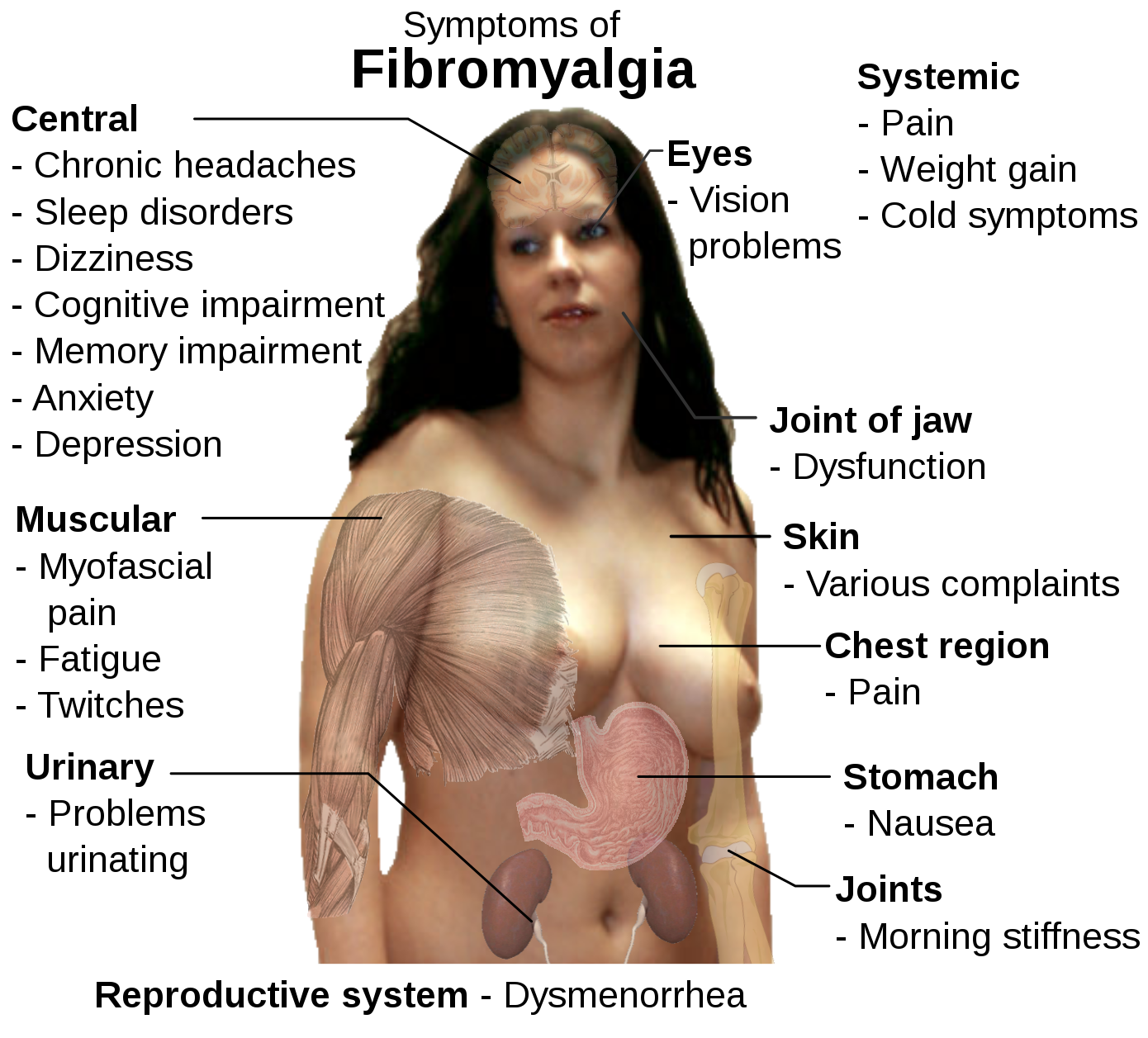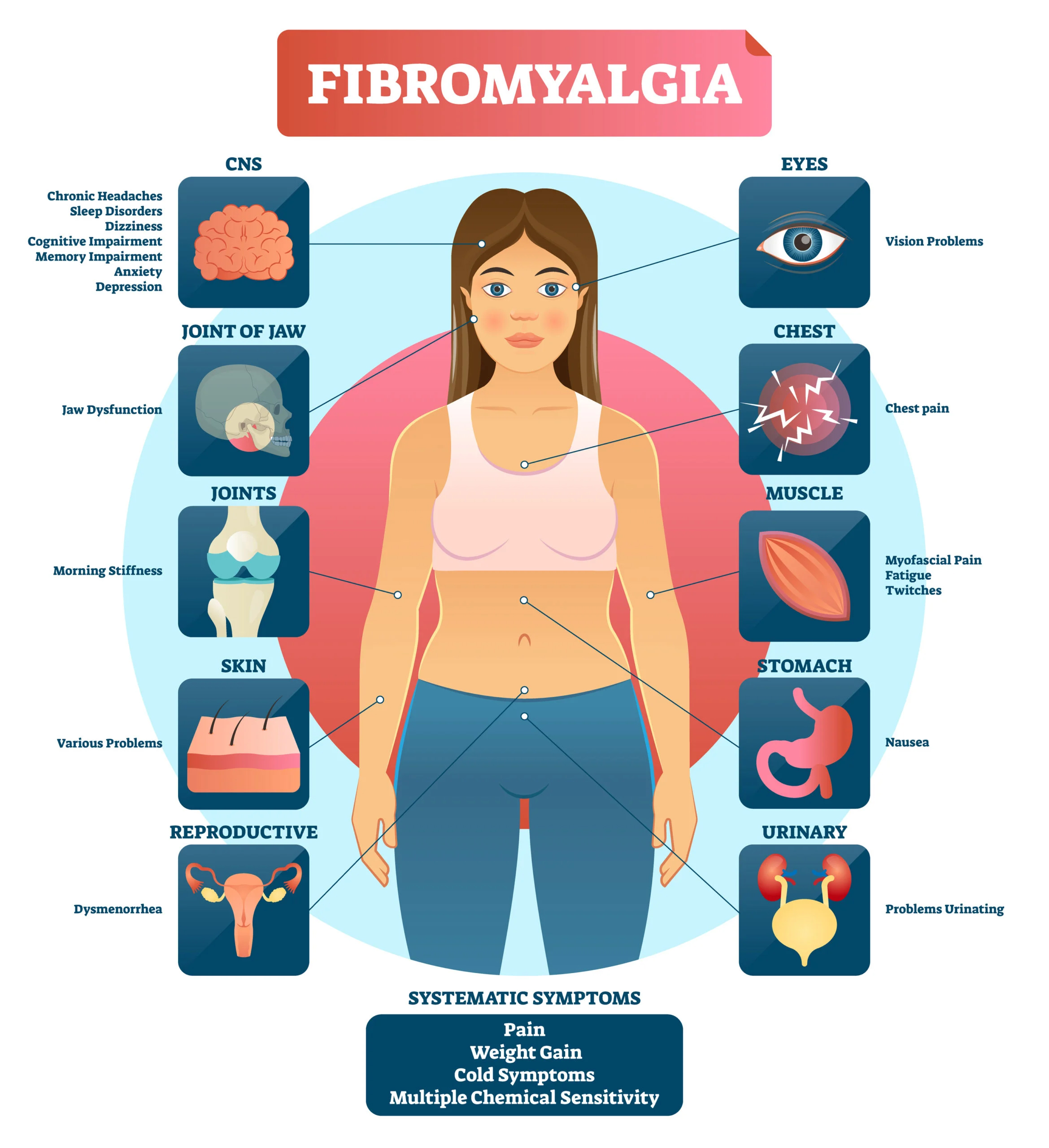
Key facts
- Fibromyalgia is a chronic condition, involving tiredness and pain in many parts of your body.
- The pain comes from a signal in your brain, not from damage to your muscles or bones.
- Your symptoms can get worse at times of stress and change. There is no test for fibromyalgia — it is diagnosed by looking at your symptom pattern.
- There is no cure for fibromyalgia, but you can learn to relieve your symptoms with a combination of lifestyle changes, psychological therapies and medicines.
What is fibromyalgia?
Fibromyalgia is a chronic condition that causes pain and muscle stiffness in many parts of your body. It can also cause a variety of other symptoms. Fibromyalgia pain comes from very sensitive nerve cells that transmit a feeling of pain, even though there is no injury or damage to your muscles and bones.
Fibromyalgia is common and affects around 2 to 5 in every 100 people. It is more common in females and during middle adulthood.
What are the symptoms of fibromyalgia?
Fibromyalgia symptoms vary from person to person. The most common symptoms of fibromyalgia are:
- pain and stiffness in many different muscles and bones, lasting for at least 3 months
- being more sensitive to pain, temperature, light, smell and noise
- extreme tiredness
- difficulty sleeping
- problems with concentration and memory
You might also have:
- anxiety or depression
- irritable bowel syndrome
- restless legs
- headaches
- numbness and tingling in your arms and legs
- painful menstrual periods
- chronic fatigue syndrome
People with fibromyalgia often find their symptoms come and go over time. You may have a ‘flare’, where your symptoms get worse, especially during times of stress such as:
- being unwell
- travel
- changes in the weather
- changes in your hormone levels or medicines
- exerting yourself too much
What causes fibromyalgia?
The cause of fibromyalgia is not completely understood. It seems that if you have fibromyalgia, chemicals are released in your brain during times of stress. These chemicals make your nerve cells very sensitive. When you encounter different sensations that are usually not painful — such as heat, cold, touch or movement — your extra-sensitive nerve cells send a message to your brain telling you that you are feeling pain.
This means that your feeling of pain is real — it simply comes from a signal in your brain, not from damage to your muscles and bones.
It’s not always clear why this happens. However, many people with fibromyalgia can identify a trigger, such as:
- an illness or infection
- an injury
- emotional difficulties
- joint inflammation, such as rheumatoid arthritis
You are more likely to develop fibromyalgia if it runs in your family.
How is fibromyalgia diagnosed?
Fibromyalgia can be difficult to diagnose, since there is no test for it and the painful areas appear normal when a doctor examines you.
You may have blood tests and x-rays to look for other possible causes of muscle and bone pain.
Your doctor will ask about your symptoms and examine you. They may diagnose fibromyalgia if they think that your pattern of pain and tiredness fits the condition.
How is fibromyalgia treated?
There is no cure for fibromyalgia, but you can learn to ease your pain and other symptoms. It’s important to learn about fibromyalgia and play an active role in your treatment. You will probably need a combination of strategies.
Pain relief techniques
Heat or cold packs, massage and movement can help relieve different types of pain. A psychologist can also help you to learn pain management skills.
Exercise
Regular exercise can reduce your pain and tiredness and improve your sleep and mood.
Exercise should be introduced slowly and gradually. Water-based exercise may be a good place to start, as the water supports the body. A physiotherapist can help you design the right exercise program for you. Tai chi and yoga may also help.
You can choose any type of exercise that doesn’t make your pain worse. However, it’s best to avoid running and jumping.
Find out more about exercise for people with fibromyalgia.
Sleep
Getting enough sleep is important. Setting aside enough time for sleep, reducing tea and coffee after lunch, relaxing before bed and getting up at around the same time each day can all help. Find out more about what you can do to get a good night’s sleep and to manage your pain when going to sleep.
Nutrition
Make sure to eat a range of healthy, nutritious foods. There is no specific diet for fibromyalgia.
Activity and rest
It’s a good idea to create healthy habits, plan your activities and schedule rest breaks. Setting goals and breaking large tasks down into several smaller tasks can help.
Psychological therapies
Psychological therapies can help you learn how to manage stress and change unhelpful thought patterns. You might try therapies such as mindfulness or cognitive behaviour therapy (CBT).
Medicines
Medicines can be helpful when combined with lifestyle changes.
Common pain relieving medicines such as paracetamol and anti-inflammatory medicines are usually not very helpful in fibromyalgia. You might use them occasionally for short-term pain relief.
Some people with fibromyalgia find that their symptoms can be controlled with medicines that are used to treat epilepsy or depression. You can ask your doctor if these may be suitable for you.






